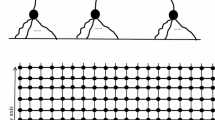Abstract
A model in striate cortex is proposed for a distributed neural representation of binocular disparity with a simple cell. In the model, disparity is represented by “far”, “near” and “tuned inhibitory” simple cells. However, the representation will be vetoed by model cells where disparity is excessively large. The veto mechanism consists of a neural network of the model cell which received output from simple cells and which interacts with neighbors. The mechanism is necessary, the model cell responds like a simple cell, and the network is physiologically plausible in the brain. Computer simulation on the neural network model with random dot stereography indicates reasonable performance.
Similar content being viewed by others
References
Adelson EH, Bergen JR (1985) Spatiotemporal energy models for the perception of motion. J Opt Soc Am [A] 2(2):284–299
Adelson EH, Bergen JR (1990) The plenoptic function and the elements of early vision. In: Landy MS, Morshon JA (eds) Computational models of visual processing. MIT Press, Cambridge, Mass, pp 3–20
Berry RN (1984) Qualitative relations among vernier, real depth, and stereoscopic depth acuities. J Exp Psychol 38:708–721
Cowey A, Rolls ET (1974) Human cortical magnification factor and its relation to visual acuity. Exp Brain Res 21:447–454
DeAngelis GC, Ohzawa I, Freeman RD (1991) Depth is encoded in the visual-cortex by a specialized receptive-field structure. Nature 352(6331):156–159
DeYoe EA, Van Essen DC (1988) Concurrent processing streams in monkey visual cortex. Trends Neurosci 11:219–226
Fender D, Julesz B (1967) Extension of Panum's fusional area in binocularly stabilized vision. J Opt Soc Am [A] 57:819–830
Fleet DJ, Jepson AD, Jenkin MRM (1991) Phase-based disparity measurement. CVGIP: Image Understanding 53(2):198–210
Foster KH, Gaska JP, Nagler M, Pollen DA (1985) Spatial and temporal frequency selectivity of neurons in visual cortical areas V1 and V2 of the macaque monkey. J Physiol (Lond) 365:331–363
Freeman RD, Ohzawa I (1990) On the neurophysiological organization of binocular vision. Vision Res 30(11):1661–1676
Gabor D (1946) Theory of communication. J IEEE 93:429–457
Horn BKP, Schunck BG (1981) Determining optical flow. Artif Intell 17:185–29
Inui T, Mimura O, Miyamoto K (1981) On the neural mechanism underlying visual acuity. Adv Neurol Sci 25(1):194–213
Jenkin MRM, Jepson AD (1988) The measurement of binocular disparity. In: Pylyshyn Z (eds) Computational processes in human vision. Ablex, Norwood, NJ
Koch C, Crick F (1991) Understanding awareness at the neural level. Behav Brain Sci 14(4):683–684
Lehky SR, Sejnowski TJ (1990) Neural model of stereoacuity and depth interpolation based on a distributed representation of stereo disparity. J Neurosci 10:2281–2299
Livingstone M, Hubel DH (1988) Segregation of form, color, movement, and depth: anatomy, physiology, and perception. Science 240:740–749
Marr D, Poggio T (1976) Cooperative computation of stereo disparity. Science 194:283–287
Marr D, Poggio T (1979) A computational theory of human stereo vision. Proc R Soc Lond [Biol] 204:301–328
McLean J, Palmer LA ( 1989) Contribution of linear spatiotemporal receptive field structure to velocity selectivity of simple cells in area 17 of cat. Vision Res 29(6):675–679
Nomura M (1990) On some important constraints on binocular vision in the brain. 3rd International Symposium on Bioelectronics and Molecular Electronics Devices. R & D Association for Future Electron Devices, December 18–20, 1990, Klobe, Japan 103–104
Nomura M, Matsumoto G, Fujiwara S ( 1990) A binocular model for the simple cell. Biol Cybern 63:237–242
Ohzawa I, Freeman RD (1986) The binocular organization of simple cell in the cat's visual cortex. J Neurophysiol 56:221–242
Ohzawa I, DeAngelis GC, Freeman RD (1990) Stereoscopic depth discrimination in the visual cortex: neurons ideally suited as disparity detectors. Science 249:1037–1041
Poggio GF, Fischer B (1977) Binocular interaction and depth sensitivity in striate and prestriate cortex of behaving rhesus monkey. J Neurophysiol 40:1392–1405
Poggio GF, Gonzalez F, Krause F (1988) Stereoscopic mechanisms in monkey visual cortex: binocular correlation and disparity selectivity. J Neurosci 8 (12):4531–4550
Reid RC, Soodak RE, Shapley RM (1991) Directional selectivity and spatiotemporal structure of receptive fields of simple cells in cat striate cortex. J Neurophysiol 66(2):505–529
Rockel AJ, Hiorns RW, Powell TPS (1980) The basic uniformity in structure of the neocortex. Brain 103:221–244
Sanger TD (1988) Stereo disparity computation using Gabor filters. Biol Cybern 59:405–418
Sugie N, Suwa M (1977) Scheme for binocular depth perception suggested by neurophysiological evidence. Biol Cybern 26:1–15
Szeliski R (1986) Cooperative algorithms for solving random-dot stereograms. Carnegie-Mellon University report CMU-CS-86-133
Wilson HR, Blake R, Halpern DL (1991) Coarse spatial scales constrain the range of binocular fusion of fine scales. J Opt Soc Am [A] 8 (1):229–236
Author information
Authors and Affiliations
Rights and permissions
About this article
Cite this article
Nomura, M. A model for neural representation of binocular disparity in striate cortex: distributed representation and veto mechanism. Biol. Cybern. 69, 165–171 (1993). https://doi.org/10.1007/BF00226200
Received:
Accepted:
Issue Date:
DOI: https://doi.org/10.1007/BF00226200




